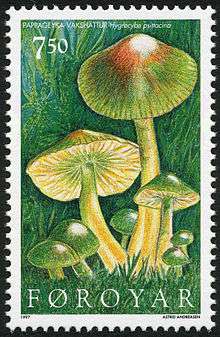Gliophorus psittacinus
Gliophorus psittacinus, commonly known as the Parrot Toadstool or Parrot Waxcap, is a colourful member of the genus Gliophorus, found across Northern Europe. It was formerly known as Hygrocybe psittacina, but a molecular phylogenetics study found it to belong in the genus Gliophorus. It had already been placed in Gliophorus, but it had been considered a synonym of Hygrocybe.[2]
Description

The Parrot Toadstool is a small mushroom, with a convex to umbonate cap 1–3 centimetres (⅓–1 in) in diameter, which is green when young and later yellowish or even pinkish tinged. The 2–4 cm stipe is green to greenish yellow. The broad adnate gills are greenish with yellow edges and spore print white. The green colouring persists at the stem apex even in old specimens.
Its odour and taste are not distinctive. There are no known chemical tests.
It fruits late summer to autumn (September to November)[3]
Distribution and habitat
Gliophorus psittacinus is widely distributed in grasslands in Western Europe, Iceland, Greenland, the Americas, South Africa and Japan, being found in late summer and autumn. In Europe it is apparently in decline due to the degradation of habitats. Early Australian records of this form have been found to be the similar green toadstools Gliophorus graminicolor or G. viridis on reexamination.
Edibility
Despite its small size and being coated in a sticky substance, Gliophorus psittacinus is often listed as edible in mushroom guides, inedible in others. Consumption of over 20 specimens in one sitting, however, can cause gastrointestinal disorders.
References
- ↑ "Gliophorus psittacinus (Schaeff.) Herink". MycoBank. International Mycological Association. Retrieved 2015-05-30.
- ↑ Babos et al. 2011. Preliminary notes on dual relevance of ITS sequences and pigments in Hygrocybe taxonomy. Persoonia 26, 2011: 99–107
- ↑ Sterry, Paul (2007). A Photographic Guide to Mushrooms of Britain and Europe. Connaught. ISBN 978-1-84517-038-7.
| Wikimedia Commons has media related to Gliophorus psittacinus. |